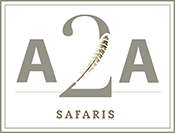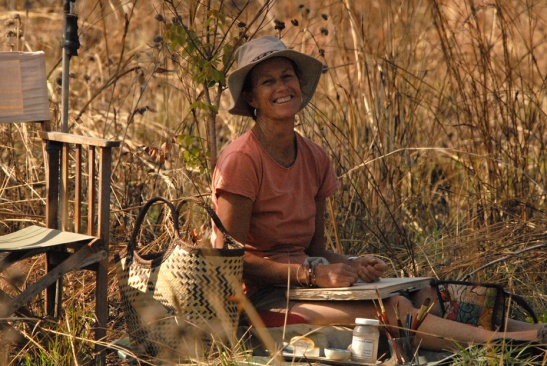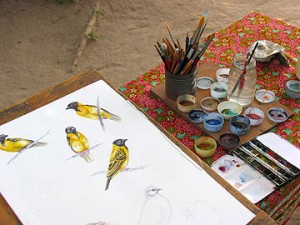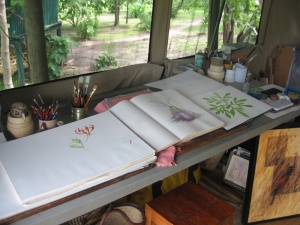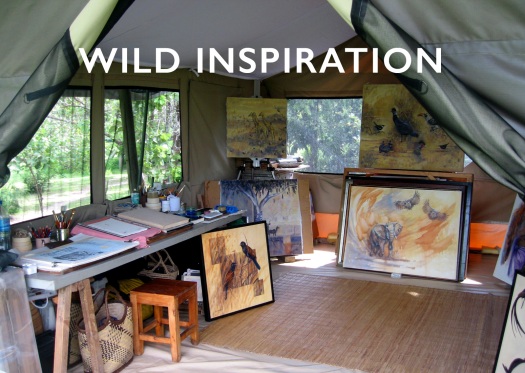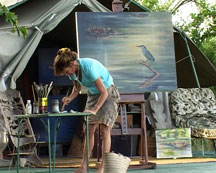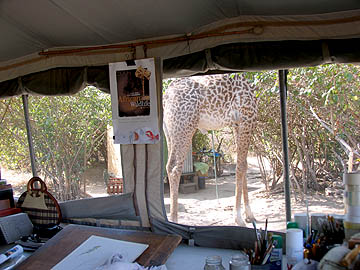A life in the wilds – Sue Stolberger.
Sue Stolberger is Ruaha’s “artist in residence” and has lived in the park for many years. She is the author of “Ruaha National Park, An Intimate View”, one of the definitive field guides to the region, as well as “The Ruaha Sketch Book”. Here we discover her remarkable story.
Sue was born in Jamaica, but when she was four years old, her parents moved to Tanzania. She grew up enjoying the pristine beaches north of Dar es Salaam, and often travelled with her parents to Tanzania’s wonderful game parks during the holidays. These trips into the wilderness were without doubt a great influence on Sue’s desire to make a career from art and wildlife.
Sue began painting seriously after leaving school, and at the age of eighteen she held her first exhibition in Nairobi, Kenya. By the time she was 22, she had decided she wanted to make a career as a wildlife artist, and so took herself off to Italy to learn what she could from the great masters. She remained there for two years, and the knowledge and experience she gained in Italy only served to fuel her dream.
Funding everything by selling her paintings, she finally returned to East Africa where her adventures in the bush – paintbrushes in hand – began. Alone in her jeep, she ventured into the wildest of places – places she thought would be interesting – continuing to develop her artistic skills by sketching and painting from life. The more remote and inaccessible the places were, the more she enjoyed it. Her quest for adventure and her wonderful experiences in the African bush coupled with her desire to paint, has created a life of fulfilment and delight.
Sue always works exclusively in the field. Over the past nineteen years she has lived and worked in National Parks in Tanzania and Kenya, worked from her mobile camp that could be set up anywhere, sleeping under the stars with just a net for protection, and working under a fly-sheet to keep the sun off. She spent two years painting scenes of the nomadic Somalis and their camels in northeastern Kenya. This was dangerous country where bandits roamed, but she never encountered any trouble. Another project saw her living alongside the Maasai, developing collections of paintings for exhibition. She spent four years captivated by the scenery and wildlife in Tsavo West National Park with fabulous views of the magnificent Mt. Kilimanjaro. Two more years were spent in Tarangire National Park in Tanzania. In 1992, she drove solo from East Africa to Namibia and back—an arduous journey that took over six months to complete. On all of her peregrinations, Sue recorded the local scenery, wildlife and people with her paintings.
For the past eleven years, Sue has been living and working in the Ruaha National Park in southern Tanzania, a place she remembers well from her childhood. Her studio is a camp on the banks of the Great Ruaha River. She finds the peace and solitude of the remote area not only conducive to painting but the best way to learn and observe from the vast array of wildlife that surrounds her home. She sketches prolifically, and never ceases to be inspired and enthralled by the diversity of light, colour, patterns and designs that nature conjures up.
“My motivation is to direct the viewer’s attention to the fascinating design and beauty surrounding us in the natural world. The patterns and combinations of colours used in display and camouflage are all so perfect in their detail. I like to focus on a subject to highlight its design, which can be almost abstracted from its form and yet still be part of its environment.”
In a recent article by Africa Geographic, Sue Has this to say about her life in the wilds:
“It is very hard to capture the true essence of life in Ruaha in words or paint. I am merely a silent observer of a tiny, tiny portion of what goes on, and has gone on, for centuries.
I distinctly remember when I was 12; I was on a game drive and I vowed that when I grew up, I would make my life in the bush and the best thing ever would be to live in Ruaha. In 1994, when I was 34, I found myself driving back to Ruaha. I was excited and curious to see how I would find it. It did not disappoint. Ruaha has been untouched since the beginning of time. It is quite honestly one of the finest wilderness areas on earth. That’s why I stayed and I have remained here for the past 11 years.
You asked what the challenges are but I am so used to living remotely that I don’t find it challenging at all, to me it is ‘normal life.’ I suppose it does require you to be pretty organized, such as when you go on a shopping trip every six weeks. You do have to eat fresh stuff in a sequence of what goes off first and then what keeps last – cabbage and squash keeps for a long time, but soft fruit does not.
People often ask me what I do if I am sick. Most of the time it is nothing serious I just spend a few days being quiet. However, on a couple of occasions I have had to be flown out with a doctor, but it all worked out. The main thing is to be organized, and know your mental and physical limitations.
On a typical day I am a very early riser, so I potter about in my pyjamas, before the sun is up, taking in the sounds. I fill up the water baths for the birds and put out a bit of seed for them. My partner and fellow artist, Rob Glen, and I have separate camps, so at about 7.30 he comes over for breakfast: fruit, porridge, toast, tea and coffee. We sit on my veranda for all meals, often joined by birds and small beasts, like squirrels during the day and genets at night. We are usually in our respective studios or out sketching by 8.30am.
In the evening I heat up water on the stove in a kettle for a shower, which is the old style bucket shower, hauled up on a pulley. We eat around 7.30pm by candle light with the stars and moon shining above. Even simple things like going down to the river each day to collect water turn out to be a magical moment for inspiration: colour on the water, a fish eagle or a dragon fly landing on a rock.
What has always fascinated me is how nature comes up with the most marvellous combinations of colour. It is these combinations of colour and design that spark many of my pictures. I have always loved painting birds; their patterns and colours are superb.
When I see something that grabs my attention, be it a sky, an animal, a person or just a combination of colours that I find interesting, I will sketch this in a journal with watercolour and keep it for future reference. Or I may be researching an animal or bird with a definite purpose, in which case I will pay particular attention to all the colours and details and spend a week or more making notes and sketches.
I paint because it is what I love to do. I paint what inspires me or challenges me. It is very hard to catch that same spontaneous ‘inspiration’ from someone else’s idea. In the few commissions I have done I am constantly wondering: ‘is this what they had in mind?’ I concluded that it would be unwise to accept commissions as, although one might be tempted to follow this route as it brings in money, in the end it will be detrimental to one’s standard of work and one’s own inspiration. I can afford not to be controlled by fear of not having enough money because I know tomorrow will take care of itself.
I have several things that are firing me up at the moment: I am working on a ‘coffee table’ type book that will be filled with paintings of the Miombo woodlands, a pristine yet underappreciated area of Ruaha. In addition to that, I am looking to create a flower and tree guide on the plants of Miombo.
I am in the process of compiling all the countless, little stories of my encounters and observations of the wonderful wildlife using photographs and sketches. And I have many oil paintings that are simmering away in my head waiting for the right moment to appear on canvas. These will be done in a random fashion in between all the other projects.
Here in Ruaha a road network is yet to be developed, so huge areas remain unscathed by humans; there is a tangible atmosphere of peace and tranquillity here. When I am alone in camp, I spend every waking moment sketching and painting, and with it being so quiet the animals come in very close – I feel like I might melt into the landscape, as somehow they seem to accept me as part of the scene.”
To see more of Sue’s work, visit her website here
